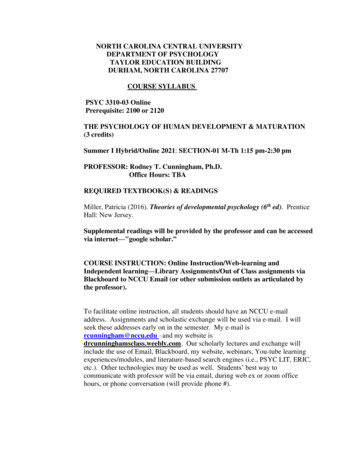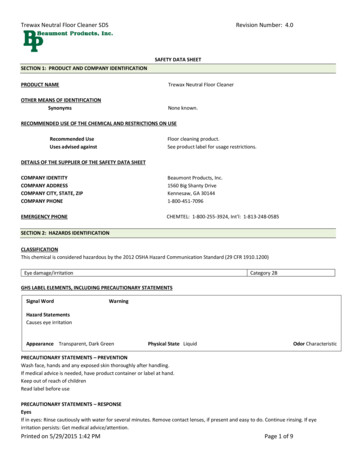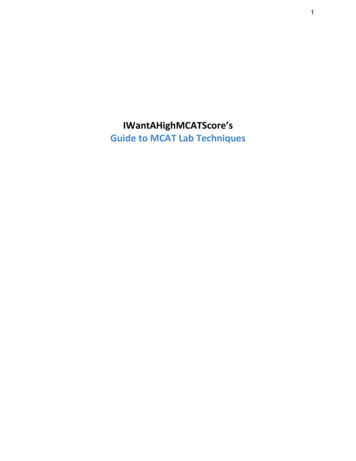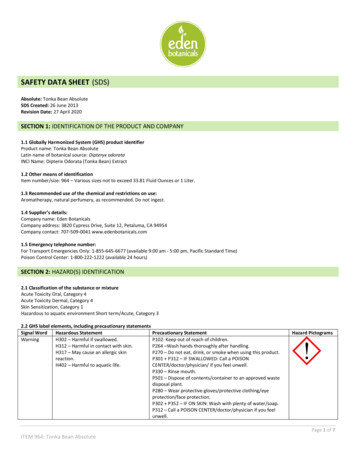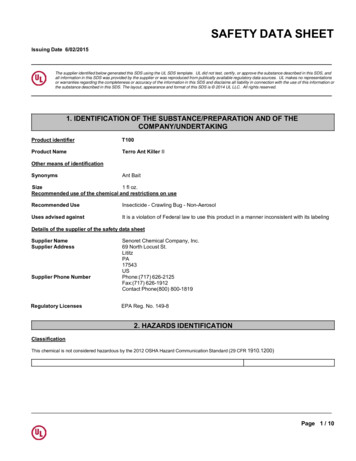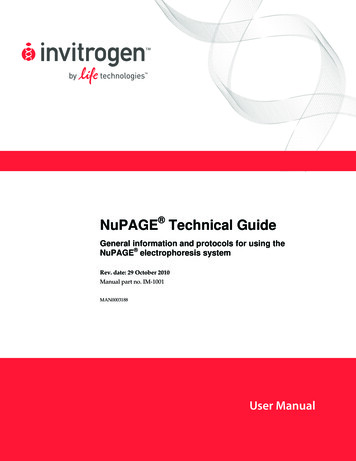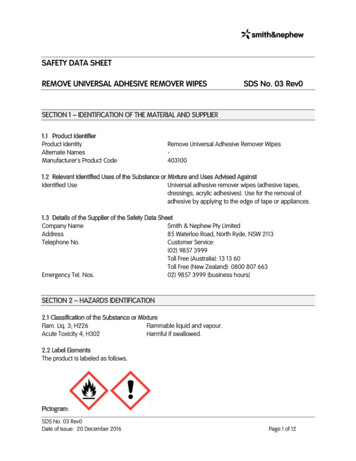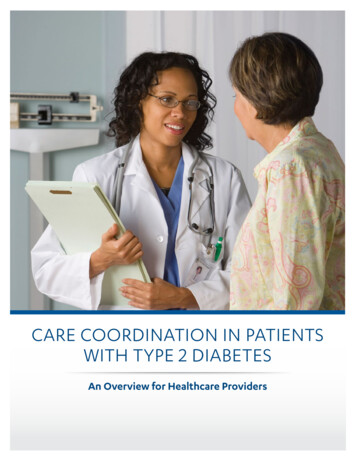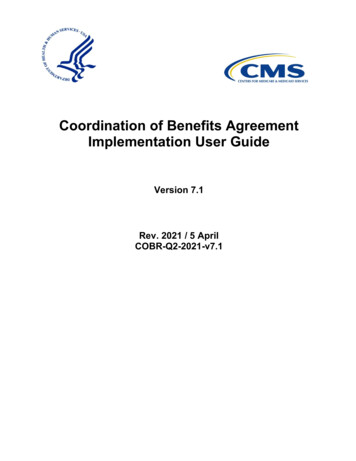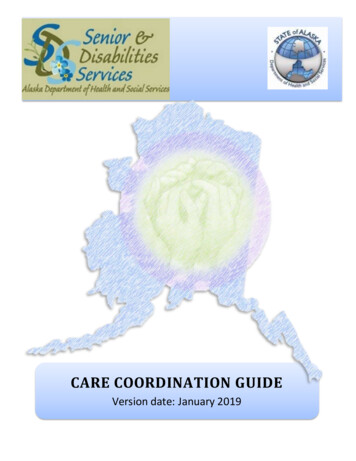
Transcription
CARE COORDINATION GUIDEVersion date: January 2019
SDS Care Coordination GuideTable of ContentsJanuary 1, 2019UNIT 1- Long Terms Support Services.7Common Acronyms, Terms and Definitions: .8Senior and Disability Services Webpage & Other Web Resources. 10ADRC: Person Centered Intake Interview. 10SDS MISSION . 11What is a “Waiver” and why do we have them in Alaska?. 11Senior and Disabilities Services offers 5 waivers:. 13UNIT 2- Becoming a Care Coordinator. 14Individual Care Coordinator and Agency Certification. 15Qualifications and Experience:. 16Care Coordination Training. 18Updating your Care Coordination training:. 19Documents needed to certify an additional CC are:. 19Initial Agency Certification Application. 20Background Check Program . 22Enrollment with Conduent. 23Connect to the SDS Harmony data system. 23Renewing Certification . 24Reimbursement for services . 24What happens when a Care Coordinator wants to discontinue his or her certification and enrollment? . 25What happens when a Care Coordinator wants to change CC Agencies?. 25Can a Care Coordination agency be sold or transferred?. 25Suspension or Denial of Certification Application, Decertification, and Appeal . 26UNIT 3 -Regulations & Responsibilities. 27REGULATORY ORDER OF CONSIDERATION. 27Federal Regulations all Providers Must Follow . 28CMS Regulation – Federal Code of Regulations (CFR) . 28Six Assurances to Centers for Medicare & Medicaid Federal Authority . 29Alaska’s application to operate HCB Waivers . 30Alaska Statutes for Medicaid Participation. 31Alaska Statues for Home and Community-Based Waiver & other SDS Services. 31Ethics & Boundaries: Some Basic Best Practices. 33Understanding Guardianship . 35What is a Power of Attorney?. 36Responsibilities of a Care Coordinator. 37On-going Care Coordination visits. 38Care Coordinators gather the planning team. 39Report changes in recipient basic information. 392
SDS Care Coordination GuideJanuary 1, 2019Adult Protective Services Mandatory Reporters . 40Protect against Conflict of Interest . 41Use Releases of Information when working with PHI- protected health information. 41Follow (HIPAA) Health Insurance Portability and Accountability Act requirements . 42Establishing a Direct Secure Messaging account: . 42Critical Incident Reports. 43Report Medicaid Fraud . 44Case Notes of Care Coordination Service . 45Records Retention schedule for the Alaska Medicaid Long Term Services and Supports. 49UNIT 4 - Eligibility . 50Medicaid Eligibility. 51Medicaid Ethics & Boundaries. 52Applicant already on Medicaid? . 53TEFRA/ Katie Beckett Waiver. 54Cost of Care (Cost of Care Co- Pay) . 55Developmental Disabilities Eligibility . 56Determining Level of Care. 56Developmental Disability Registry. 57IDD/ISW Waiver Eligibility: diagnosis . 58ICAP Assessment and ICF/IID Level of Care. 59Applying for the IDD/ISW Waiver . 60Interim year Assessment (the years between the ICAP cycles). 64Nursing Facility LOC. 64ADRC Person Centered Intake Requirement. 64ALI/APDD/CCMC/CFC Application. 65Determining (NFLOC) Nursing Facility Level of Care . 69Table of Nursing Facility Level of Care, skilled services & intermediate services. 70CAT (Consumer Assessment Tool) . 76Admission to a Skilled Nursing Facility . 76Preparing for the Assessment. 77Assessments in a Nursing Facility or Long Term Care Hospital . 77UNIT 5 – HCB Services. 79Community First Choice Services . 80Waiver Service Definitions, Regulations, and Basic Exclusions. 81Requesting Safeguard Funding for the ISW Waiver . 87Services through Grants . 88Senior Grants for Home & Community Based Services. 88Other Resources For Individuals with Developmental Disabilities . 89Nursing Home transitional services. 903
SDS Care Coordination GuideJanuary 1, 2019HCBS Settings Compliance . 91Requesting Services during temporary absence. 93Out of Home Residential Services. 94Waiver Transportation Services. 95Duplications with Personal Care Services (PCS) or CFC-PCS Services. 96Environmental Modifications (E-Mods) . 97Specialized Medical Equipment . 104Nursing Oversight and Care Management. 105Supported Employment. 107Acuity Rate for Out of Home Residential Services. 108Unit 6 - Writing a Person Directed Plan for Supports. 109People get the support they need from many resources . 109Person Centered Approach. 110Each Support Plan is Individualized. 111Personal Goals in the Support Plan. 112Some Resources for Person Centered Planning . 113Developmental Disabilities Shared Vision . 114Writing Narrative in the Support Plan. 115Use person first language to accurately describe disability. 115Be clear and precise. 115Identify strengths . 116Identify Barriers . 116Refer to the assessment and other documents . 117Collect ongoing supporting information when you visit . 117. 118What Are Habilitation Services?. 118Developing Goals & Objectives for Habilitation Services. 121Habilitation Services Goals. 121Assessing risks for habilitation services. 122Providing support for habilitation goals . 123Goals for habilitation services . 123What is an objective? . 123What does “measurable” mean?. 124Please note that narrative progress is required in addition to any quantitative data. The care coordinator needs thisinfo when planning services or renewal. . 125Habilitation services to help decrease behavior. 125What are the “interventions”? . 126What if goals change during the current Support Plan?. 127Renewal planning for goals and objectives? . 1274
SDS Care Coordination GuideJanuary 1, 2019What is SDS looking for?. 128Goals and the accompanying objectives must be:. 128Be Cautious of these types of goals: . 128Writing in Plain Language . 130What are the main elements of plain language?. 130Goals of Plain Language . 131Apply plain language to your writing?. 131Support Plan Questionnaire. 135Unit 7 - Renewing CFC and Waiver Services. 136LOC Reapplication. 136Material Improvement Review Process (MIRP). 137Fair Hearing & Hearing Process Rights . 138Mediation -1St Step. 138Fair Hearing – 2nd Step . 139Transfer of Care Coordination. 139Closing a Waiver . 140Community First Choice (CFC). . 141. 141Other Resources. 153Medicaid (PCS) Personal Care Services Eligibility . 153Current SDS Contacts . 157DISCLAIMER:The information contained in this training was current at the time it was written. It isnot intended to be all inclusive, grant rights, impose obligations, or function as a standalone document. Although every reasonable effort has been made to assure theaccuracy of the information in this document, the ultimate responsibility for compliancelies with the provider of services. The State of Alaska, Department of Health and SocialServices, Division of Senior and Disabilities Services employees and staff make norepresentation, warranty or guarantee that this compilation of information is error-freeand/or comprehensive and will bear no responsibility or liability for the results orconsequences of the use of this curriculum.5
SDS Care Coordination GuideJanuary 1, 2019Welcome!We’re glad you’ve chosen to study the profession of Care Coordination with Senior and DisabilitiesServices. Alaska needs you and your skills to help seniors and individuals experiencing a disability live full liveswithin our community. This guide is designed to provide you with basic information and procedures onaccessing Home and Community Based Waiver Services for Alaskans. Mastering the information of this guidealone will not qualify you as a Care Coordinator. There are specific educational and professional experiencequalifications required to become a Care Coordinator. (See Unit 2 of the guide.) You must become certifiedwith SDS, and enrolled with Alaska Medicaid; or become certified and work for a care coordination agencywhich is enrolled. Even with the basic qualifications, the best practice for a new Care Coordinator is to spend alot of time with a mentor. You may consider contacting a local Care Coordinator about mentorship possibilities.You may also choose to join your local Care Coordination Network association.Stay informed: The practices described in this training are current as of the date on this guide. The SDS training teamincludes the latest known updates. Please check the SDS Website for changes.1Training materials will beupdated to reflect changes as they progress. Join the SDS E-Alert System. SDS emails updates for all its’ programs to providers. 2About Critical Incident Report (CIR) TrainingSDS requires Critical Incident Report Training prior to Certification and verification again at Recertification.This guide gives an introduction to Critical Incident Reporting. To receive the required certificate of attendancefor Critical Incident Report Training you must either enroll in the SDS Critical Incident Reporting Webinar orparticipate in Critical Incident Report training facilitated by your employer agency. 3 You may also register for anSDS lead Critical Incident Report training webinar through the SDS webpage under Provider Training.If you have questions about training please email the training inbox at SDSTraining@alaska.gov orcall the training unit at 907-269-3666, or 1-800-770-1672.Kara Thrasher- Livingston907-269-3685Training Specialist IIICina Fisher Training Specialist II907-269-3734Cassandra Lynch Health Program Associate, Training907-269-3448Delight Mells, Training Specialist I907-269-36721 Alaska’sSeniors and Disabilities Services Website: http://dhss.alaska.gov/dsds/Pages/default.aspx .SDS E-Alert List Serve sign up: s3 SDS Critical Incident Reporting Training Video & form26
SDS Care Coordination GuideWhy should I find a mentor?January 1, 2019A beginning Care Coordinator should try to find a mentor- an a currently certified Care Coordinator who canshare his or her knowledge and experience. Training can bring you technical information and updates, but youwill gain more through on the job experience. A “trainee” who is not certified and enrolled cannot create andauthorize documents; they cannot conduct visits with clients alone or sign any documentation until the traineeis certified by SDS. However, as a trainee you can become familiar with the daily work of a Care Coordinatorthrough the process of shadowing. This will allow for you to practice interacting with people, learn theprocesses and work with sample documents.You may wish to connect with a local Care Coordinator Association to find a mentor. The Alaska CareCoordination Network is a good place to start. 4 They have contacts in various regions of the State. Some CareCoordinator Agencies pair experienced Care Coordinators with new ones in a training plan.When you find a mentor, here are some basic mentorship questions you may consider asking:1) What expectations does my mentor have?2) What are my expectations for the outcome of the mentoring experience?3) Will there be a learning plan, and what are the basic attributes of this? (forexample, how often will we meet ?)4) How will I know I am making progress?UNIT 1- Long Terms Support ServicesTerms and DefinitionsSenior and Disabilities Services WebpageMission & Service PrinciplesWhat is a Waiver?Six Assurances to CMS4Alaska Care Coordination Network: http://www.alaskaccn.com/index.html7
SDS Care Coordination GuideCommon Acronyms, Terms and Definitions:January 1, 2019A&GAdministrative and GeneralAACAlaska Administrative CodeABPCAAgency Based Personal Care AgencyACoAAlaska Commission on AgingADLActivities of Daily Living: walking, eating, dressing, bathing, toileting and transferringADRCAging and Disability Resource CenterADRDAlzheimer’s Disease and Related DisordersAdult Day Services: programs providing adults with various social and some health-oriented servicesin a supervised outpatient group settingAid to Families with Dependent ChildrenADSAFDCAlaska 211ALHALIALLANPAPDDAPSASCare CoordinationServicesCATCCDial 211 for general information and resources for publicly funded assistance by the United WayAssisted Living Home: Helps adults who are frail and/or cognitively impaired maintainindependence and dignity by providing assistance with activities of daily livingAlaskans Living Independently: a Waiver authorized in Alaska, for adults 22 & over with significantneeds for daily living supports. (formerly Older Alaskans OA and Adults with Physical Disability APD)Assisted Living Licensing (DHCS)Advanced Nurse PractitionerAdults with Physical & Developmental Disabilities: a Waiver authorized in Alaska for people 21 andover who experience significant Physical and developmental limitationsAdult Protective Services (SDS)Alaska StatuteAssists clients in gaining access to natural supports, community services and Medicaid waiverservices. Care coordinators are responsible for initiating and overseeing the planning process, aswell as the ongoing monitoring and annual review of a recipient’s eligibility and Support Plan.Consumer Assessment ToolConduentCare CoordinatorCommunity First Choice: an option (NOT a Waiver) for people who meet level of care for a facility:NFLOC, ICFIID, or IMDChildren with Complex Medical Conditions: a Waiver authorized in Alaska, for children and youngadults under the age of 22 years, who require a level of care ordinarily provided in a nursing facility.Consumer Directed Personal Care AgencyThe process of becoming approved to provide services that are reimbursable by Medicaid.Certification is obtained by application to DHSS or SDS, depending on the clients served.Alaska’s Fiscal agent for MedicaidDHCSDivision of Health Care Services – State office which administers Alaska MedicaidEMTEmergency Medical TechnicianProviders certified by SDS apply for enrollment through Conduent to bill for services provided toMedicaid clients.Fiscal interface for provider se systemEPSDTGRHarmonyHCBHCBSHCBS SettingsEarly and Periodic Screening Diagnostic Treatment (“regular” Medicaid for individuals up to age 21.)General Relief: a program that provides temporary funding for housing accommodations outside ofan institutional environment.Harmony Data System is a secure electronic filing system that providers submit requireddocumentation to SDS on behalf of their clients. This is a new system and providers are beingsystematically on boarded in 2019.Home and Community BasedHome and Community Based ServicesAll Medicaid-funded services must be provided in settings that exhibit home and community basedcharacteristics and do not isolate recipients. All providers must ensure that all settings owned,rented, leased, and/or contracted must be in compliance.8
SDS Care Coordination GuideJanuary 1, 2019IATHome and Community Based Waivers: a choice to receive home and community based care ratherthan care in a nursing facility or institution. Established through 1915(c) Social Security Act andregulated in Alaska under 7AAC 130.200-7AAC 130.319.Information and ReferralInstrumental Activities of Daily Living: laundr
1. Ensure agency Harmony users have a need for access to the data system 2. Verify users have current Alaska Background checks complete 3. Monitor compliance of agency users to the individual user agreement 4. Report changes in name, position or affiliation to the agency for all of the individual agency users 5.

